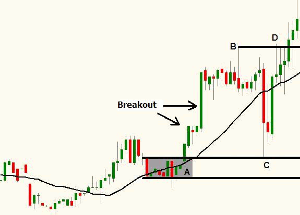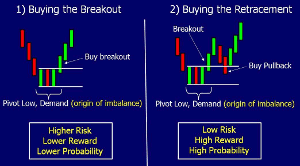When taking any buy or sell entries in markets, make sure you know exactly where price is with regard to the larger time frame supply/demand curve, writes Sam Seiden of Online Trading Academy.
I have been in the trading business for over 15 years as a trader, fund manager, and trainer, beginning on the floor of the Chicago Mercantile Exchange. While I feel like I have seen it all, the one thing that still surprises me is how most traders handle breakouts. Most traders seem to let emotion complicate what can really be a simple, rules-based, and very profitable strategy. Trading breakouts can be high risk, high stress, low reward, and low probability, or this strategy can be low risk, low stress, high reward, and high probability. The difference lies in how you “think the markets.” Do you think like a novice retail trader or do you think like an institution? The answer determines how you enter into this type of position and that’s the key when it comes to success or failure with the breakout strategy.
Before getting into the details of the strategy, it’s important to understand two key components of markets.
1) Why do prices move in any market? Price in any market turns at price levels where demand and supply are out of balance. The consistently profitable trader is able to identify a demand and supply imbalance, which means knowing where the REAL buyers and sellers are in a market.
2) Who is on the other side of your trade? Trading is simply a transfer of accounts from those who don’t know what they are doing into the accounts of those who do. The consistently profitable trader knows whether the person on the other side of their trade is a novice trader or a consistently profitable institution.
NEXT PAGE: Breakouts and Breakdowns |pagebreak|
The Logic
Notice area A, the origin of a strong rally in price. Most breakout traders will look to buy as price breaks out to the upside from area A. This type of breakout entry is typically the “sucker bet.” Traders see price moving higher from area A and they give in to emotion and buy into that initial rally because they see others buying. The problem is that by the time you buy the breakout of area A, price has moved so far that it becomes a high-risk and low-reward trade. Instead, I sit back and let the breakout happen because that breakout tells me that there is a demand and supply imbalance at area A; this is exactly where the institutions are buying. Next, I wait for price to return to area A. When it does at C, I am a very interested buyer as I am confident I am buying from a novice seller. I know this because the seller at C is making the two mistakes that every consistent losing (novice) trader makes. First, they are selling after a period of selling and second, they are selling at a price level where demand exceeds supply.
The Breakout Trade
The Setup
For longs, many people like to use moving averages to identify trend and that’s ok, you can try a 20-period moving average. When it’s sloping up, you’re in an uptrend. Next, identify the origin of a strong move in price and draw two lines around the price action to create a demand zone (area A). An ideal pattern is the “Drop-Base-Rally”. In other words, area A should be preceded by a decline in price. Then, make sure there is a significant profit margin (profit target). This would be the distance from area A to B, the highest high of the initial breakout before price returns to A at C.
The Action
Buy at C when price touches the top black line and place your protective sell stop just below the lower black line. Adjust your position size so that you are not risking more than you are willing to lose. Place your profit target based on the high of the initial breakout B, which in this case would have you selling for a profit at D.
The Breakout: Two Types of Entries, Very Different Odds
The Breakdown: Two Types of Entries, Very Different Odds
The proper breakout entry works in any market and any time frame. A key component to making these work that is beyond the scope of this article is this: When taking any buy or sell entries in markets, make sure you know exactly where price is with regard to the larger time frame supply/demand curve. Whether you trade stocks, futures, forex, and options, understand that behind all the candles on your screen in all these markets are people and their emotions. Most will fall for the emotional trading traps set by fear and greed, others get paid from this type of novice thinking.
By Sam Seiden,Vice President of Education, Products, and Services, Online Trading Academy













